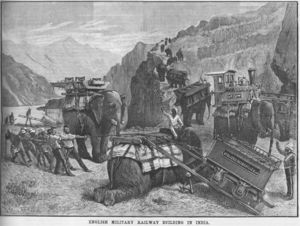Difference between revisions of "Bolan Pass Railway Construction"
(Complete rewrite with Links References, etc) |
('Category:Portable Railways' and 'Decauville Portable Railway System' info and links added) |
||
| Line 11: | Line 11: | ||
[[File:Bolan Pass Railway Construction.jpg|thumb|Bolan Pass Railway Construction - early 1880's using Elephants to transport the Decauville railway components]] | [[File:Bolan Pass Railway Construction.jpg|thumb|Bolan Pass Railway Construction - early 1880's using Elephants to transport the Decauville railway components]] | ||
| − | Work restarted shortly after using by rapidly laying a rail track in the bed of the river Bolan and finally a steam locomotive rolled into [[Quetta]] in August of 1886. The 1885 account given in Practical Machinist <ref name=prac.mac>[http://www.andrewgrantham.co.uk/afghanistan/elephants-carrying-locomotives-through-the-bolan-pass/ "Elephants carrying locomotives through the Bolan Pass" – ‘Scientific American’, 15 August 1885; Posted 28 March 2010]; Retrieved 5 Dec 2016</ref> states | + | Work restarted shortly after using by rapidly laying a rail track in the bed of the river Bolan and finally a steam locomotive rolled into [[Quetta]] in August of 1886. The 1885 account given in Practical Machinist <ref name=prac.mac>[http://www.andrewgrantham.co.uk/afghanistan/elephants-carrying-locomotives-through-the-bolan-pass/ "Elephants carrying locomotives through the Bolan Pass" – ‘Scientific American’, 15 August 1885; Posted 28 March 2010]; Retrieved 5 Dec 2016</ref> states "This railroad is of the [[Decauville Portable Railway System|'Decauville System']], formed in sections of small steel rails, which can be put down or taken up very quickly.... the locomotive made in two parts, the larger of which weighed on 3,978 pounds, the greatest weight that an elephant can carry”<ref name=prac.mac/>. |
[[Francis Langford O'Callaghan]], posted from the [[State Railways]], was ‘Engineer in Chief’ for a number of demanding railway projects, surveys and constructions on India's north-west frontier .. including.. the Bolan line through the Bolan Pass to Quetta, 1885-86" <ref>[http://www.icevirtuallibrary.com/doi/abs/10.1680/bdoceigbai.58347.457 Institution of Civil Engineers "Biographical Dictionary of Civil Engineers in Great Britain and Ireland - O'Callaghan, Francis Langford "]; Retrieved on 13 Jul 2016</ref>. | [[Francis Langford O'Callaghan]], posted from the [[State Railways]], was ‘Engineer in Chief’ for a number of demanding railway projects, surveys and constructions on India's north-west frontier .. including.. the Bolan line through the Bolan Pass to Quetta, 1885-86" <ref>[http://www.icevirtuallibrary.com/doi/abs/10.1680/bdoceigbai.58347.457 Institution of Civil Engineers "Biographical Dictionary of Civil Engineers in Great Britain and Ireland - O'Callaghan, Francis Langford "]; Retrieved on 13 Jul 2016</ref>. | ||
| Line 27: | Line 27: | ||
[[Category:Railway Constructions]] | [[Category:Railway Constructions]] | ||
[[Category:State Railways]] | [[Category:State Railways]] | ||
| + | [[Category:Portable Railways]] | ||
Revision as of 04:19, 12 March 2017
Bolan Pass Railway Construction
Background
It was the year 1857 when the idea was suggested by William Andrew (Chairman of Scinde, Punjab and Delhi Railway) that the railways to the Bolan Pass would have strategic role in responding to any threat by Russia. During the second Afghan War (1878–80) between Britain and Afghanistan, a new urgency was needed to construct a Railway line up to Quetta in order to get easier access to the frontier. This was described as the Quetta Link Railway (see for more information)
Orders for a feasibility survey for the Bolan Pass Railway were first issued by the British Government in 1876 [1].
On 18 September 1879, under the orders of Viceroy council, work begun on laying the railway tracks and after four months the first 134 miles (215 km) of line from Ruk was completed and become operational in January 1880 reaching Sibi on 2 May 1880 [2].
Work on the construction of railways through the Pass started in 1880 but was soon stopped after laying of 31km track due to the occurrence of the famous Battle of Maiwand in the area.
Work restarted shortly after using by rapidly laying a rail track in the bed of the river Bolan and finally a steam locomotive rolled into Quetta in August of 1886. The 1885 account given in Practical Machinist [3] states "This railroad is of the 'Decauville System', formed in sections of small steel rails, which can be put down or taken up very quickly.... the locomotive made in two parts, the larger of which weighed on 3,978 pounds, the greatest weight that an elephant can carry”[3].
Francis Langford O'Callaghan, posted from the State Railways, was ‘Engineer in Chief’ for a number of demanding railway projects, surveys and constructions on India's north-west frontier .. including.. the Bolan line through the Bolan Pass to Quetta, 1885-86" [4].
In 1889 a torrential flood destroyed the track which was first laid on the Bolan River bed. A new track was laid at a higher altitude but that also got washed away.
In 1890 orders were issued for laying an all season track through the Pass. This new track was inaugurated on April 15, 1897 and named the Mushkaf-Bolan Railway. The railway was incorporated into the North Western Railway(NWR) network.
The present day railway track through the Bolan Pass is the third attempt of laying railways through the pass and is still operational. At some places along the track one can see the abandoned tunnels and the rail bed of two earlier attempts of laying railways here [1].
References
- ↑ 1.0 1.1 "Railway line through the Bolan Pass By Owais Mughal" published by 'All Things Pakistan', 23 Aug 2006; Retrieved 5 Dec 2016
- ↑ “Administration Report on Railways 1918” page 108 (pdf117); Retrieved 5 Dec 2016
- ↑ 3.0 3.1 "Elephants carrying locomotives through the Bolan Pass" – ‘Scientific American’, 15 August 1885; Posted 28 March 2010; Retrieved 5 Dec 2016
- ↑ Institution of Civil Engineers "Biographical Dictionary of Civil Engineers in Great Britain and Ireland - O'Callaghan, Francis Langford "; Retrieved on 13 Jul 2016
